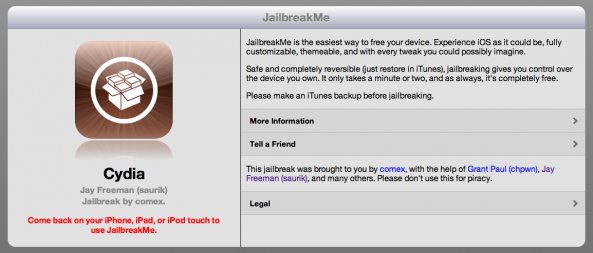
JailbreakMe 3.0 recently went live for all iDevices on iOS 4.3.3, and Comex’s PDF exploit is the first to successfully jailbreak the iPad 2.
Although the process of jailbreaking with JailbreakMe is incredibly easy, many of you probably still have questions concerning the userland jailbreak. The iPhone Dev Team has put together a helpful FAQ outlining the details behind JailbreakMe 3.0…
Q: Which devices and firmware versions are supported?
A: In this initial release, the following configurations are supported:
- iPad1: 4.3 through 4.3.3
- iPad2: 4.3.3
- iPhone3GS: 4.3 through 4.3.3
- iPhone4: 4.3 through 4.3.3
- iPhone4-CDMA: 4.2.6 through 4.2.8
- iPod touch 3g: 4.3, 4.3.2, 4.3.3
- iPod touch 4g: 4.3 through 4.3.3
Q: Do the holes discovered by @comex put my device at risk?
A: Yes. We recommend installing “PDF Patcher 2” in Cydia once you’re jailbroken to eliminate this risk (any firmware version).
Q: How does jbme3.0 differ from the existing jailbreaks?
A: jbme3.0 is entirely userland-based, from start to finish. The A5 chip in the iPad2 has no iBoot or bootrom-level exploits yet, so tools like redsn0w, PwnageTool and sn0wbreeze can’t use the limera1n bootrom exploit to inject the jailbreak. Even for those devices where limera1n works, jbme3.0 injects the jailbreak with a userland exploit.
Q: If I’m already jailbroken on the latest firmware, is there any advantage to jailbreaking again?
A: No, but you should consider showing this to your friends! Spread the jailbreaking fever.
Q: Are the holes exploited by jbme3.0 closed in iOS5?
A: The holes still exist in the iOS5 betas, but they’ll almost certainly be fixed by the time iOS5 is public. However because the iPad2 had no public jailbreak yet, it probably wasn’t worth waiting until the fall to use them. If history repeats itself though, there will be more holes and exploits.
Q: Will I permanently lose the jailbreak if I need to restore my device?
A: For all except the iPad2, saving your SHSH blobs should let you always restore your device to iOS versions where this jailbreak works. The iPad2 is a little more complicated. If you have a wifi-only iPad2 and saved SHSH blobs, you’re in good shape. But if you have the GSM or CDMA iPad2, you won’t be able to restore to 4.3.3 or lower once Apple stops signing its baseband. There are a few ideas that might work to get around this limitation, but for now it’s best to assume there’s no going back to 4.3.3 once 4.3.4 is out for iPad2 GSM or CDMA owners.
Q: I heard this new unionfs stuff is dangerous?
A: Define dangerous 🙂 Seriously though, although unionfs is a huge improvement to the install time of the jailbreak, it is brand new code and there is the possibility something will go wrong. Just keep regular backups of your media and content and you should be fine. If there are any problems, they should appear within the first few days, so hold off and let “everyone else” test the waters if you’d like.
Comex also answered a pressing question about JailbreakMe’s PDF exploit:
Q: Isn’t there a risk hackers will make the exploit from this site into an iPhone virus?
A: When I released JailbreakMe 2.0 last year, some media reports focused on the security implications of releasing an exploit for unpatched vulnerabilities. I am not sure myself what to think of this, but here are some facts:
- I did not create the vulnerabilities, only discover them. Releasing an exploit demonstrates the flaw, making it easier for others to use it for malice, but they have long been present and exploitable. Although releasing a jailbreak is certainly not the usual way to report a vulnerability, it still has the effect of making iOS more secure in the long run.
- There’s always a first time, but I think there’s a good chance the security impact of these vulnerabilities will remain theoretical. Despite JailbreakMe 2.0 being open sourced after an updated version of iOS was released, which would have made it relatively easy to modify the code into an attack, I didn’t hear about any such modification except a proof of concept that showed up much later. The only iPhone virus ever to attack the general public was a trivial one that affected jailbreakers who installed OpenSSH (not installed by default) but left it at the default password.
- Along with the jailbreak, I am releasing a patch for the main vulnerability which anyone especially security conscious can install to render themselves immune; due to the nature of iOS, this patch can only be installed on a jailbroken device. Until Apple releases an update, jailbreaking will ironically be the best way to remain secure.
- Jailbreak apps and tweaks improve the mobile experience of millions of users, including many who were encourged to try it by the ease of use of web-based jailbreaks. I’m not just doing this to be flashy: there is considerable benefit to writing this kind of tool rather than one that requires a connected computer.”
For an ongoing list of user-submitted questions and concerns you can check out the Jailbreak QA page.
Any more questions?